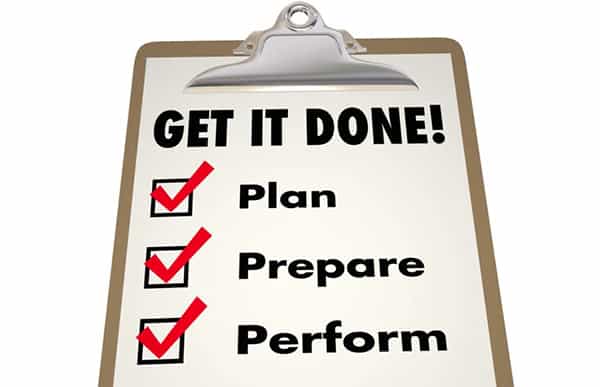Written by Ari Greenbaum, Co-founder of conXpros
Sales makes the (business) world go-round. Every business relies on sales to drive revenue and growth. Regardless of your personal level of affinity towards sales, to every home improvement pro, it is the lifeblood of your business. In this article, I will share a plan that will turn yourself (or your sales team) into a well-oiled, deal closing, revenue generating machine.
Imagine going into a battle without a plan…….do you have that image yet? Not a pretty outcome. The selling process should not be a battle, but without the proper plan, the outcome will be just as gruesome more often than not. Even the most seasoned selling professionals need a strong, rehearsed and perfected game plan. There is no shame or detraction from ego to approach sales in this manner. Take football as an example; in the NFL players are exceptionally skilled and highly paid for those talents, yet every team practices, drills, creates & implements a game plan for every game. What would your favorite team look like on the field if they went out there and tried to rely on talent and just “winged” it? That gruesome image returns.
Just like every game is different in football, not every customer is the same. But every game plan is built on the same basic fundamentals & here I will focus on the fundamentals of a successful sales process and the most effective way to put it into action.
Step 1: Planning
Successful sales presentations start by asking not telling. As opposed to going full throttle into how wonderful you & your company are, focus on the person that matters most; your potential client. The outline for a successful sales presentation should look like this:
- Introduction/greeting
- Discovery/needs assessment
- Transition
- Pitch
- Close
Introduction/greeting: Create a natural greeting that allows you to immediately show the client that you are friendly and excited to have the opportunity to help in their need. Nothing too cheesy, but enough to get off to a positive start
Discovery/needs assessment: Develop the questions that will help you understand the needs of the client. This will vary based on the type of service you offer, but focus on getting a clear picture of what is important to them (style, functionality, cost, longevity, guarantees, budget, etc). Try to uncover the “pain points” of the client, that once solved, make saying yes a natural conclusion. This MUST be done in a conversational manner. No one likes to feel like they are being interrogated. Develop a flow of questions that naturally lead from one to the other. I always suggest mixing in some “nail downs” along the way to bring the key factors into better focus. Be careful to keep the feeling that the needs assessment is about the client, not you gaining the tools you will need to close the deal (even though that is a result of proper discovery). The key to making discovery a powerful tool is your ability to listen to understand, not just to respond. Check out this article which focuses on effective listening skills.
Transition: Once a thorough needs assessment is done, create a transition into the next step, the pitch. Often this will involve walking the house or assessing the project/space. Always try to have the client with you during this process. This allows you to show your expertise while performing an evaluation/assessment, learn more about the needs (new questions arise when assessing the project “together”, and keep them engaged by removing potential distractions.
Pitch: Develop a sales pitch that focuses on who you are, why you are the absolute best, builds value in your service and/or product, educates the client, and most importantly helps connect the dots of how you will meet the needs of the client better than anyone else (based on the discovery/needs assessment). If you are selling a product, incorporate physical samples. I have always found that incorporating some real-life stories into your presentation helps paint a relatable picture for the client. People connect emotionally to stories (here is a great article to better understand the power of storytelling in sales).
Close: If you do not ask for the sale, you rarely get the sale. There are many different options when it comes to creating an effective close. Develop a closing sequence that fits you, your product/service, and is clear what you are asking for. Often, after a successful sales presentation the prospective client will still have a few questions before the final yes, so don’t be discouraged. The first close is a critical step in the selling process. It allows you the potential to get the immediate yes, and if not, get a clear reading on the client’s level of engagement and interest. If you have done an effective job on the above steps, you should close with confidence.
Step 2: Prepare
You can develop the best sales process possible, but fail miserably in execution if you forget the most important step……PRACTICE. We all know the old saying, practice makes perfect. By the time you are face to face with a client, you should feel like you have been in this situation hundreds of times before. Practice through role play with colleagues, or in the case of sales teams, practice together (regularly). The key to effective practice is to practice like you play. I coach my son’s little league team and preach this same concept. Amazingly, the boys that joke around all practice ad do not take it seriously, tend to make the most fundamental errors in the games (fielding errors, errant throws, poor batting). On the other hand, the ones that take practice seriously and treat practice like a game, are the ones making the all-star team every year. If you want to be a sales all-star, take your preparation and practice seriously. This level of preparation allows you to enter every sales presentation with the highest level of confidence and most importantly, focus on the client and their needs instead of trying to remember your pitch. PRACTICE, PRACTICE, then PRACTICE some more.
Step 3: Perform
Now that you have created the process & rehearsed it, the time has come to put it into action. This requires getting in front of potential clients, giving them your absolute best and executing the game plan. Consistency is key, stick with your plan. Resist the urge to make reactionary changes to your sales presentation based off singular encounters. Of course, you want to improve your process by making tweaks, but do so only after a large enough sample size. The results in the field will be a direct result of how much energy is put into steps 1 & 2.
Start making gameday into payday for you and your sales team. Plan and develop your process, practice it, & prosper from it.

